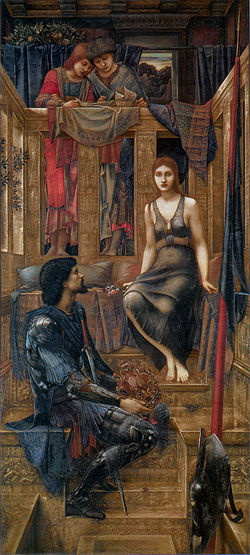Major treatments
The Cophetua story was famously and influentially treated in literature by Alfred, Lord Tennyson (The Beggar Maid, written 1833, published 1842); in oil painting by Edmund Blair Leighton (The King and the Beggar-Maid) and Edward Burne-Jones ( King Cophetua and the Beggar Maid , 1884); and in photography by Julia Margaret Cameron and by Lewis Carroll (his most famous photograph; Alice as "Beggar-Maid", 1858). Tennyson's poem was set to music by Joseph Barnby (published 1880).
The painting by Burne-Jones is referred to in the prose poem König Cophetua by the Austrian poet Hugo von Hofmannsthal and in Hugh Selwyn Mauberley (1920), a long poem by Ezra Pound. The painting has a symbolic role in a short novel Le Roi Cophetua by the French writer Julien Gracq (1970). This in turn inspired the 1971 film Rendez-vous à Bray , directed by the Belgian cineaste André Delvaux.
The story was combined with and inflected the modern re-telling of the Pygmalion myth, especially in its treatment by George Bernard Shaw as the 1913 play Pygmalion , though Henry Higgins does not, in the play, display any romantic attraction to Eliza Doolittle whatsoever; thus, the parallel with the 'king and the beggar-maid' is not valid.
It has also been used to name a sexual desire for lower-class women by upper-class men. Although often attributed first to Graham Greene in his 1951 novel The End of the Affair , the term was used as early as 1913 by P.G.Wodehouse in his novel The Little Nugget, when Peter Burns reflects that ‘…I was King Cophetua. If I did not actually say…this beggar maid shall be my queen…’ and also in 1942 by Agatha Christie in her mystery The Body in the Library [NY: Collier, pp. 119-121] when Jane Marple reflects on the attraction of older wealthy men for young lower-class girls and in 1861 where Anthony Trollope referred to the story in Chapter XXXV of Framley Parsonage, his fourth novel of The Barchester Chronicles. Sir Henry Clithering in The Body in the Library dubs it a "Cophetua Complex."
Elizabeth Goudge refers to the story in her 1950 novel Gentian Hill (Book I "The Farm", Chapter III, Part I, p 37) in relation to the impetuous springtime mating of an aristocratic hound with a beautiful sheepdog, explaining the mixed-parentage and character of their surviving puppy.
The English poet and critic James Reeves included his poem "Cophetua", inspired by the legend, in his 1958 book The Talking Skull.
Hugh Macdiarmid wrote a brief two-verse poem Cophetua in Scots, which is a slightly parodic treatment of the story. [11]
Polish composer Ludomir Rózycki wrote a symphonic poem "Król Cophetua", Op. 24, in 1910.
Alice Munro titled one story in her 1980 collection, "The Beggar Maid". Before her marriage to Patrick, Rose is told by him: "You're like the Beggar Maid." "Who?" "King Cophetua and the Beggar Maid. You know. The painting." The American edition of Munro's collection is also titled The Beggar Maid, a change from the Canadian title, Who Do You Think You Are?

